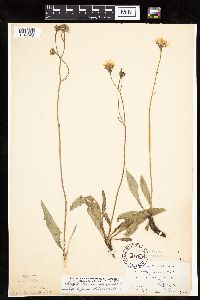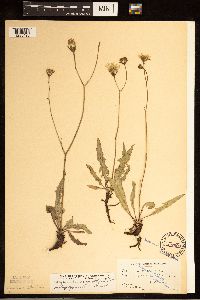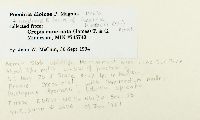Crepis runcinata
|
|
|
|
Family: Asteraceae
Fiddle-Leaf Hawk's-Beard, more...fiddleleaf hawksbeard, dandelion hawksbeard, fiddle-leaf hawksbeard
[Crepis runcinata var. alpicola] |
Perennials, 15-65 cm (taproots relatively long, caudices swollen). Stems 1-3, erect or ascending, scapiform, branched near middles, glabrous or hispid, sometimes stipitate-glandular distally. Leaves mostly basal (rosettes); petiolate; blades elliptic, lanceolate, linear, oblanceolate, obovate, or spatulate, 3-30 × 0.5-8 cm (bases attenuate) margins usually entire or weakly dentate, sometimes serrate, dentate, or pinnately lobed, apices rounded, faces glabrous or hispid to hispidulous (sometimes glaucous). Heads (1-)3-15(-30), borne singly or in ± corymbiform arrays. Calyculi of 5-12, narrowly triangular, glabrous or tomentulose bractlets 1-3 mm. Involucres turbinate-campanulate, 7-21 × 8-12 mm. Phyllaries 10-16, lanceolate or oblong, 8-10 mm, (bases keeled and thickened, margins scarious) apices usually acute, sometimes attenuate or obtuse (often ciliate-tufted), abaxial faces glabrous or tomentulose, sometimes stipitate-glandular, adaxial glabrous. Florets 20-50; corollas golden yellow, 9-18 mm. Cypselae dark to golden reddish or yellowish brown, fusiform, 3.5-8 mm, tapered distally or beaked, ribs 10-13 (strong); pappi white, 4-9 mm. Crepis runcinata is recognized by its basal rosettes of weakly dentate or almost entire leaves, scapiform stems, branching near middles, and reduced cauline leaves. The stems and leaves are usually glabrous. Multiple subspecies were described by E. B. Babcock (1947); the variation is continuous. Babcock suggested that this is the only American species that shows a relationship to Asian species.
General: Perennial, 15-65 cm tall; stems 1-3, erect to ascending, branched, glabrous or hispid, sometimes stipitate- glandular; caudex somewhat woody, swollen; taproot fairly long. Leaves: Mostly basal (forming rosettes), simple, oblanceolate, elliptic, or obovate, 3-30 cm long, 0.5-8 cm wide, cauline blade, if present, solitary, greatly reduced, surfaces glabrous or hispid, sometimes glaucous, margins entire or weakly dentate, sometimes serrate, dentate, or pinnately lobed, apex rounded; blades petiolate. Flowers: Heads (10) 20-60, arranged in compound corymb- or panicle-like arrays; bractlets (subtending the involucre) 6-8, triangular, 2-4 mm long, tomentose; involucre narrowly cylindric, 1-1.6 cm long, 3-5 mm wide; phyllaries 7-10, lanceolate, 1-1.3 cm long, more-or-less tomentose; ray flowers only, 7-12, 14-30 mm long, yellow; flowers May-July. Fruits: Achene, 3-8 mm long, light to dark brown, strongly 10-13 ribbed, the apex tapered or beaked; pappus 4-9 mm long, white. Ecology: Moist meadows, seeps, other wet habitats; 1200-2800 m (3900-9200 ft); Apache, Coconino, Gila, and Navajo counties; western Canada, western U.S. Notes: Two ssp. occur in Arizona and are distinguished as follows: ssp. barberi has narrowly oblanceolate to linear leaves, 0.5-2 cm wide; ssp. glauca has obovate, oblanceolate, or spatulate leaves, 1.5-4 cm wide. Editor: Springer et al. 2008 Perennial (1-)2.5-5(-8) dm with one or several strong roots; herbage glabrous or occasionally glandular-hispidulous; basal lf-blades narrowly obovate, elliptic, lanceolate, or spatulate, 0.5-3.5 cm wide, 4-8 times as long, sessile or longer than the petiole, entire to remotely dentate or runcinate-pinnatifid; cauline lvs few and much reduced; heads (1-)3-7(-12); invol 9-16 mm, ±glandular-hairy or hispid, sometimes also tomentose, the outer bracts seldom over half as long as the 10-15 inner ones; fls 20-50; achenes (3.5-)4-5.5(-7.5) cm, contracted at the top, but not beaked, brown, 10-13-ribbed; 2n=22. Moist open places; w. Minn. to Alta., Wash., Calif., and n. Mex. June, July. Our plants, as here described, are var. runcinata. (C. glaucella) Gleason, Henry A. & Cronquist, Arthur J. 1991. Manual of vascular plants of northeastern United States and adjacent Canada. lxxv + 910 pp. ©The New York Botanical Garden. All rights reserved. Used by permission. |
|
|
|
























































































